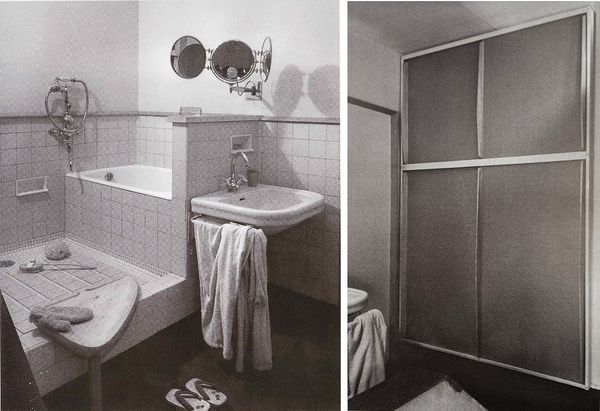Charlotte Perriand and Jean Prouvé, Prototype "Brazza" cabinet, from the apartment of Charlotte Perriand, rue Las-Cases, Paris, 1950–1951. FREESTYLE: Living with Art & Design.
In 1950, Charlotte Perriand was commissioned to design the interiors and furnishings for the Unité d'habitation Air France in Brazzaville, Republic of the Congo. The four-story building, designed by the architects Jean Hébrard, R. Lefebvre, Jean Létu, and François Bienvenu, comprised sixty apartments of varied types to house Air France employees in Brazzaville, a then central connection point for flights within Africa. Perriand enlisted Les Ateliers Jean Prouvé assist with the production of the storage systems for the building devising cupboards that were built into recesses in the concrete walls of the apartment kitchens, living rooms, and bedrooms. Prouvé’s expertise in folded metal and closet systems was crucial to the design. Perriand, however, aesthetically improved Prouvé’s existing designs going as far as to change dimensions, materials, colors, and forms with an eye towards complementing the primary colors and grid-like structure of the exterior façade of the building.

Advertisement for Ateliers Jean Prouvé in L’Architecture d’aujourd’hui, April 1952. Artwork: © 2024 Artists Rights Society (ARS), New York / ADAGP, Paris.
This collaboration between the two designers would prove quite fruitful, with Perriand writing to Prouvé, “To start, I am very happy about the ‘Brazza’ prototype. I believe that this time we’ve gotten it right and that these façades fulfill the desires of a large number of architects: elimination of awkward constraints, combination of traditional architecture and factory built facades easy to include in a plan, rapid mounting, a luxury finish for a modest price, installation with ventilation for tropical countries, unventilated installation for Europe.” The design for the Brazza cabinet marked Perriand’s first large-scale collaboration with the Ateliers Jean Prouvé and Perriand was so pleased with the design that she installed the present prototype of the Brazza cabinet into her apartment on la rue Las-Cases during renovations to the apartment in 1951.

Compact bathroom incorporating the Brazza cabinet at the Salon des arts ménagers, Paris, 1952. Artwork: © 2024 Artists Rights Society (ARS), New York / ADAGP, Paris.
Interestingly, in Paris, the Brazza cabinet proved suitable to satisfy different needs than in Brazzaville. The French version, which went into wider production, differed slightly from the Brazzaville version: the left side was designed for toiletries, the right side for clothes, and the upper portion for long-term storage. Perriand included plexiglas trays that were standardized to fit different items such as shirts, underwear, paper, files, or envelopes, which could be pulled in and out of the closet on sliding tracks. By 1958, these trays were mass produced, becoming one of Perriand’s most successful and widely distributed designs. In 1952, she incorporated the present prototype cabinet into a bathroom design presented at the Formes utiles exhibition at the Salon des arts ménagers in Paris. This installation promoted Perriand’s philosophy for improving the design for bathing and grooming inspired by her time in Japan. On the occasion of the exhibition she said, “It isn’t nice to bathe in polluted water (which is the case of the bathtub), or to deprive yourself of relaxing in the bath after a shower, or taking a cold shower after getting out of the bathtub while keeping your feet in hot water. You have to think about and treat bathroom fixtures not in an off-putting way, but by making their use pleasant.” The Brazza cabinet served as efficient and elegant storage for linens and toiletries, intended to replicate Perriand’s own ways of living with her designs.

Sketch by Charlotte Perriand illustrating the Japanese-inspired bathing concept underlying the bathroom design. Artwork: © 2024 Artists Rights Society (ARS), New York / ADAGP, Paris.
